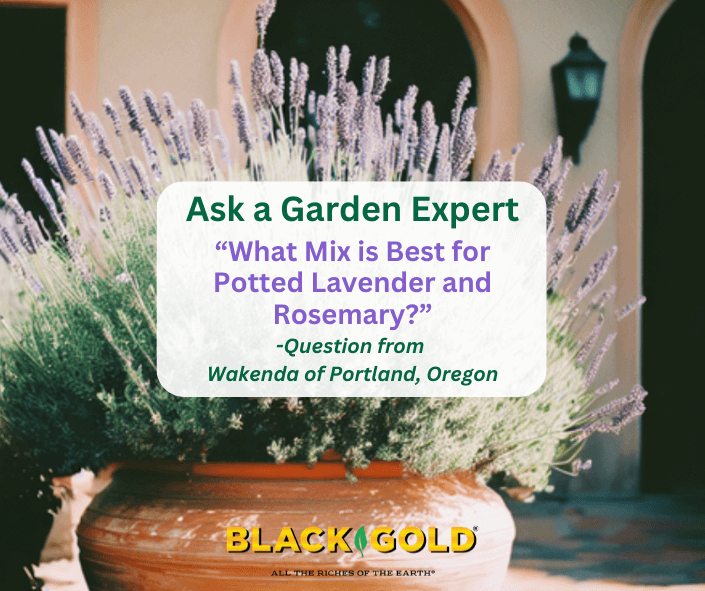
“What is the best soil mixture for potted rosemary and lavender?” Wakenda of Portland, Oregon.


Parsley, Sage, Rosemary, and Thyme is one of the most popular songs by Simon and Garfunkel, and both the herbs and song are favorites. But, what about basil? Shouldn’t basil be a part of the song lyrics? Truly, the addition of basil would create a wordier line in the song, but the addition of the herb would complete my list of top herbs to grow in summer. (We will leave parsley out because most gardeners start the plant as a spring herb.)
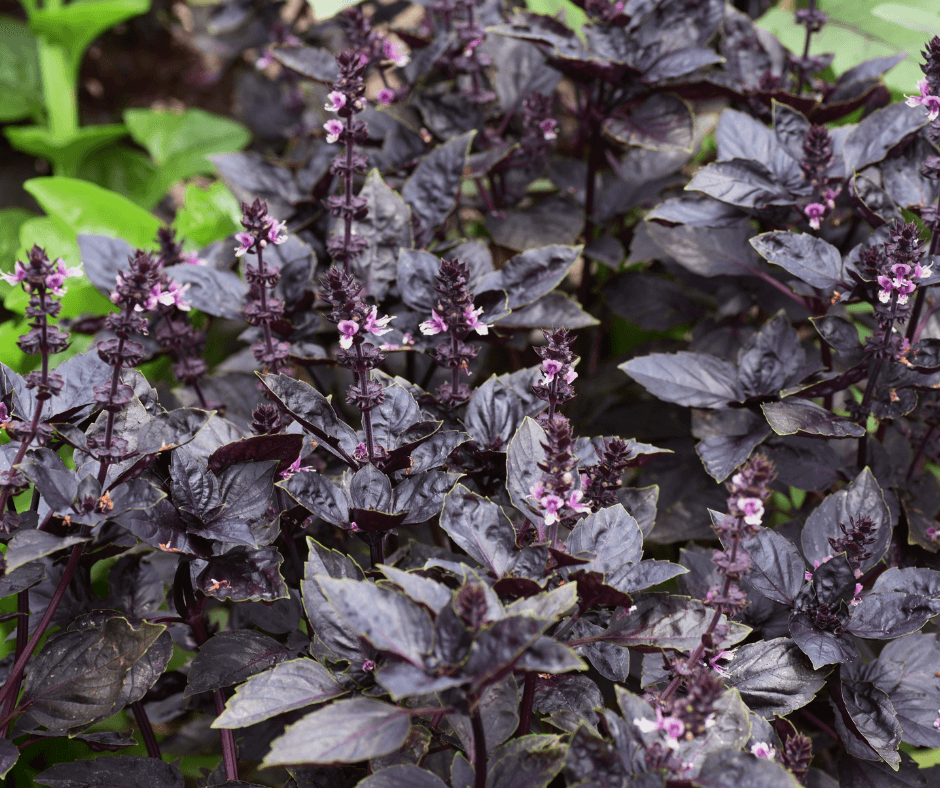
Basil (Ocimum basilicum) is one of the most important culinary summer herbs, and the plant is steeped in history and folklore. It is probably the most well-known and widely grown of all the summer herbs. Although ubiquitous to southern European cuisine, basil is a native of Africa, Asia, and parts of the Middle East. The word itself, basil, is believed to be derived from the Greek Basilikon phuton which means “kingly herb.”
In my summer garden, I would never be without a container or two of basil. There are many different cultivars–too many to list. Basil flavors range from sweet basil, such as ‘Genova’ or ‘Lettuce Leaf’, to the anise-scented leaves of Thai basil (Ocimum basilicum var. thyrsiflora, ‘Siam Queen‘ is a beautiful flowering form), or the lemony leaves of ‘Mrs. Burns’ ‘Lemon basil (Ocimum basilicum var. citriodora ‘Mrs. Burns). There are also colorful purple and red basils, such as ‘Dark Purple Opal‘ or the maroon ‘Osmin‘, etc.
While I always try a new variety each year. Last summer, I grew ‘Emerald Towers’ for the first time. It grew, as the name implies, in more of a pyramid shape, and, as advertised, the plant produced no flowers. The leaves had the same flavor as sweet basil. It was so effortless, I plan to grow one in a pot near the kitchen door for summer!
Basil plants will bloom with spikes of white or lavender flowers, but I recommend gardeners pinch the flowers off, so the plant will continue to produce new leaves rather than seeds. Sometimes, in the fall I leave a few flower spikes when plants are tired because they seem to be a magnet for honeybees.

Sage (Salvia officinalis) is another easy-to-grow summer herb originating from the Mediterranean. In our Pacific Northwest climate, the shrubby, evergreen will overwinter as a perennial (USDA Hardiness Zones 5-11). The attractive plants look good either in ornamental gardens or herb gardens.
There are quite a few garden-worthy culinary sage varieties with variations in leaf color from standard green to purple to variegated forms, which usually have leaves with purple tones and white margins. The large-leaved ‘Berggarten‘ sage has big, rounded, felty-green leaves, and the purple, ivory, and green-leaved ‘Tricolor‘ sage is both good-looking and savory. In the spring or early summer, the sage plants produce spikes of lavender-blue flowers visited by bees.
Any sage can be grown as an attractive potted plant, if given full sun a large pot filled with quality, well-drained soil and regular water.
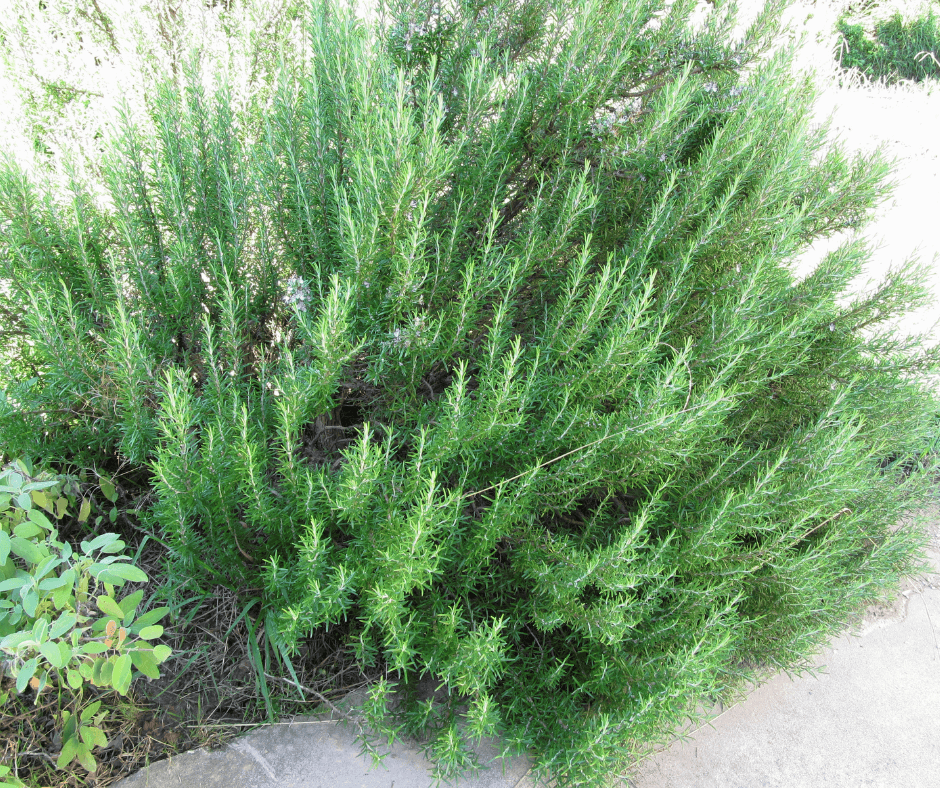
Another shrubby perennial herb is rosemary (Rosmarinus officinalis, USDA Hardiness Zones 7-11). While many plants did not survive our January ice storm last winter, rosemary plants usually live through our winters. Fortunately, some cultivated varieties are hardier than others. ‘Arp‘ is a selection that tends to be more winter-hardy than others and can survive winters up to Zone 6.
Rosemary grows to be a large, attractive plant in the garden. Specimens can reach 3-feet or more. In fact, they are often grown as shrubs in the Mediterranean. For their best chance of survival, choose a full-sun location with sharply-drained soil. The roots will not tolerate wet feet in the winter.
Small spikes of flowers appear along the stems in various shades of lavender-blue, sometimes white, in the late spring or early summer. There are trailing forms that are ideal for planting along a retaining wall or in a large container. ‘Prostratus‘ (Zones 8-11), which can reach a foot or so and spread to 3 feet or more, is the most common creeping form available.
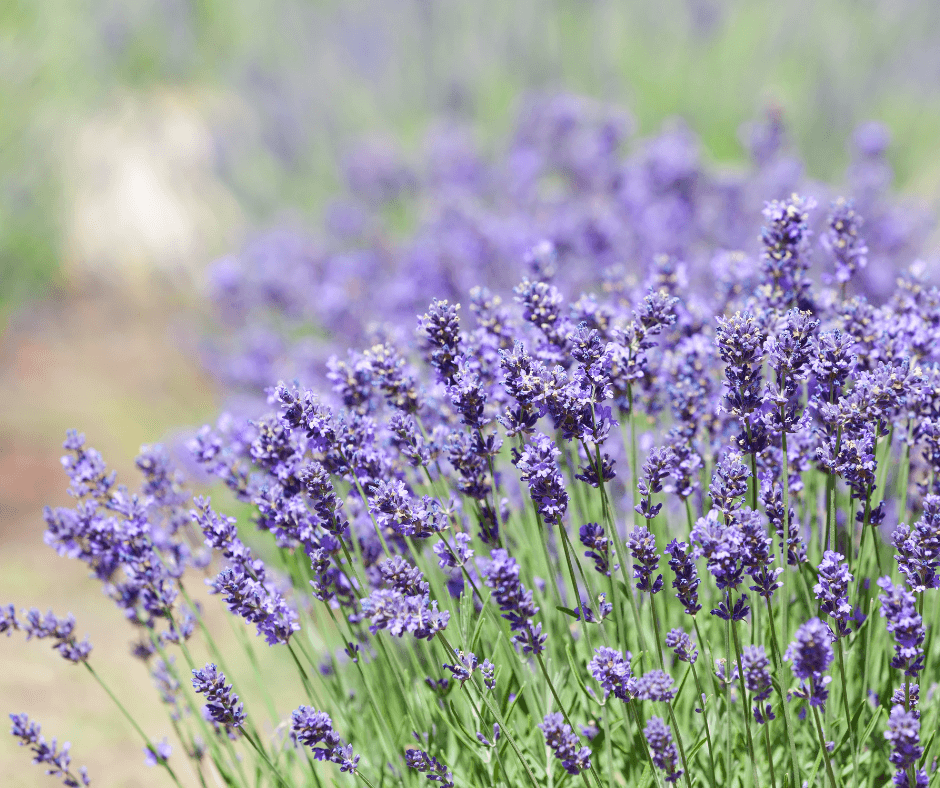
Few herbs are as strongly identified with fragrance and color as lavender (Lavandula spp.). There are many beautiful species and varieties to try, including the classic, compact ‘Munstead’ English lavender (Lavandula angustifolia ‘Munstead’), and lovely ‘Lady’ lavender (Lavandula ‘Lady’), which blooms in the first year from seed. ‘Vera‘ (Lavandula angustifolia ‘Vera’) is another compact form known for its strong, aromatic fragrance and dense wands of lavender-blue flowers.
Lavender is a short-lived shrubby perennial, which varies in hardiness depending on the species. English lavender (Lavandula angustifolia), the hardiest form, will survive in Zone 5 or 6. All grow best when given full sun and soil with good drainage. Like rosemary, they do not appreciate wet feet in the winter. With good care, plants will survive for four to five years before they begin to decline and require replacement.
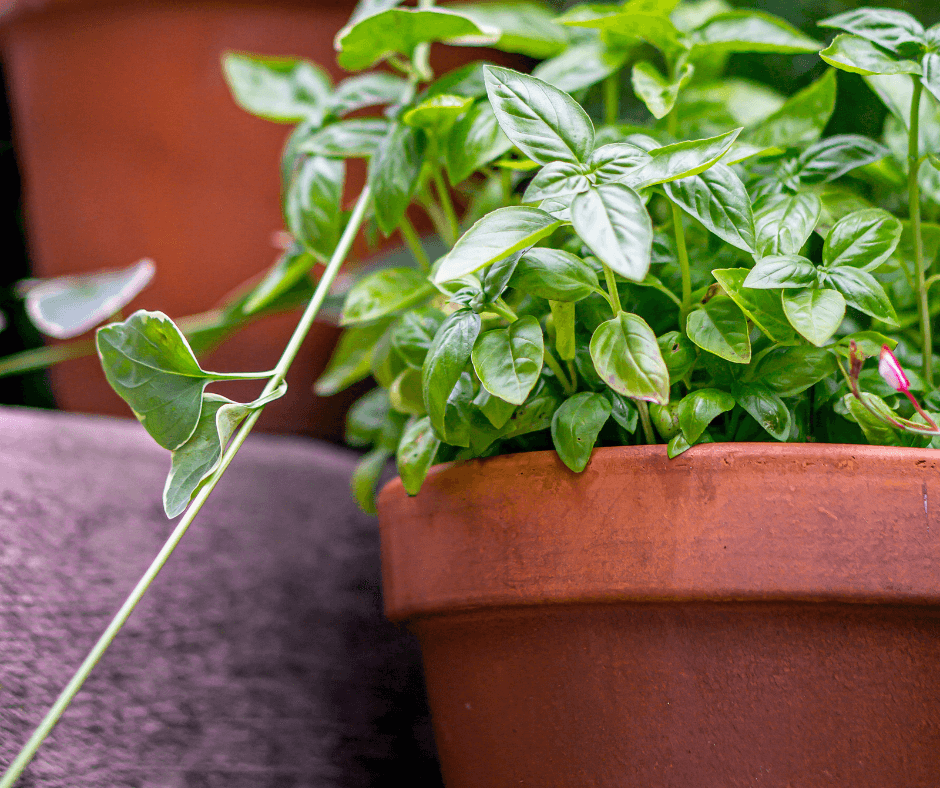
All of the herbs listed need warm temperatures, and a rule of thumb should planted outdoors after the threat of frost has passed. A full-sun location is required. For plants in containers, all will thrive in Black Gold Natural & Organic Potting Mix. The addition of perlite and pumice to increase drainage is recommended. Add three parts mix to one part pumice/Black Gold Perlite, and make sure the container is large and has drainage holes at the base.
There are so many different herbs that are readily available to the home gardener. If you have a favorite, check out the herb section at your local garden center for the best plants in your area. While many may not be winter hardy, they can provide great satisfaction during the summer months.
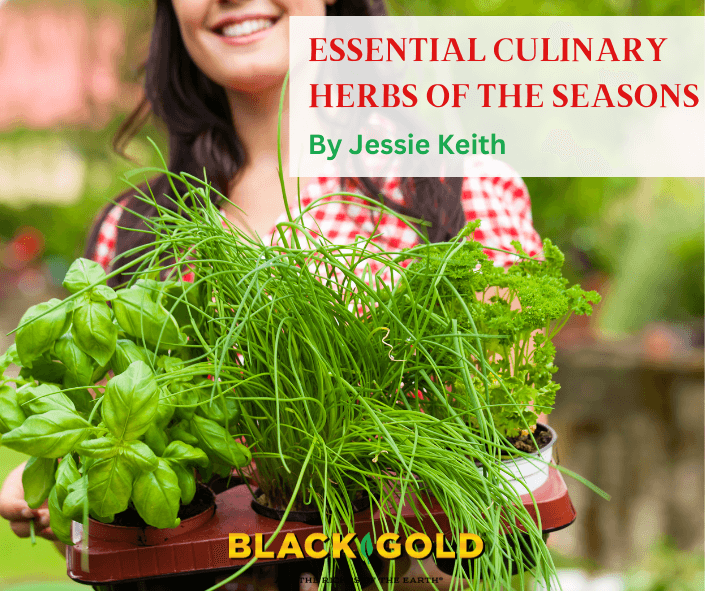
Stylish and serviceable herb gardens are a delight through the growing season when they appeal to the eye and senses and provide fresh herbs. In winter, stores of dried and frozen herbs make cooking a pleasure. If you don’t already have a culinary herb garden, you are missing out. And, there’s no reason not to grow one. Essential culinary herbs are the easiest plants in a food gardener’s repertoire.
Every culture relies on essential herbs to flavor its foods. In past blogs, we have written about French herb gardens, Indian herb gardens, herbal tea gardens, herb containers, lemon-scented herbs, and apothecary gardens, but oddly enough, we have never written about growing herbs essential to Western cuisine. These are the common (and pricy) herbs that homeowners buy at the grocery store (even though they grow like weeds). Herbs are yawn and water garden plants unless you want to make a show and create a formal herbary or knot garden.

The first chives of spring are so bright and welcome when added to fresh vegetables and salads, as are the tender leaves of parsley when they begin to unfurl and are at their sweetest. Fine cilantro and dill–both cool-season annuals–are two other spring herbs no garden should be without. In late spring, count on chamomile to produce its sweet daisies that are harvested and dried to make delicious, soothing tea to enjoy year-round. These are the spring herb essentials.
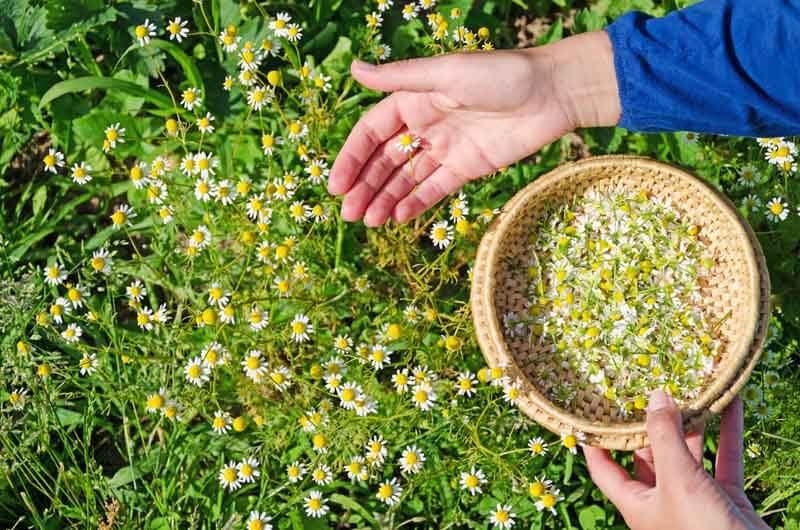
Chives (Allium schoenoprasum, USDA Hardiness Zones 4-8): Chives put forth tidy clusters of oniony, grassy foliage in spring. Pompons of edible mauve flowers bloom in mid-spring, rising above the upright foliage. Harvest them fresh, when they are most flavorful. In summer, chives wane in the heat but will often perk back up in fall.
Chamomile (Matricaria retutica, Zones 2-8) is a winter annual or short-lived perennial to sow in fall. It will overwinter as a ferny green rosette and then bloom in full glory with a flurry of small white daisies in spring. Harvest the flowers for drying when they just begin to open. Allow some plants to set seed to encourage new fall seedlings.
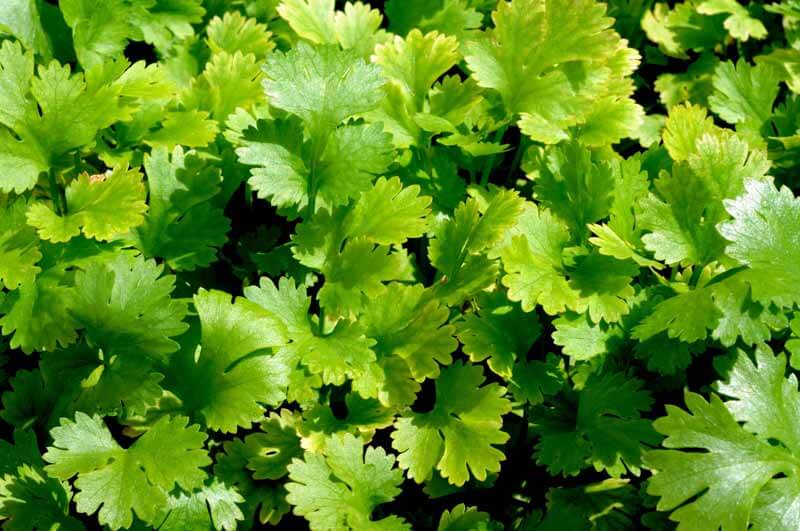
Cilantro (Coriandrum sativum) is a leafy annual that likes it cool and starts producing stems of white flowers and seeds as the weather heats up. But, that’s a good thing because its seedheads, which dry by summer, are crushed to make the spice coriander. Harvest the leaves while you can for guacamole, salads, and salsas. Also, consider cilantro a fall herb to seed in no later than early September.
Dill (Anethum graveolens) is a true spring annual herb that you only need to plant once. Harvest the ferny green leaves to flavor salads, spreads, and pickles, and
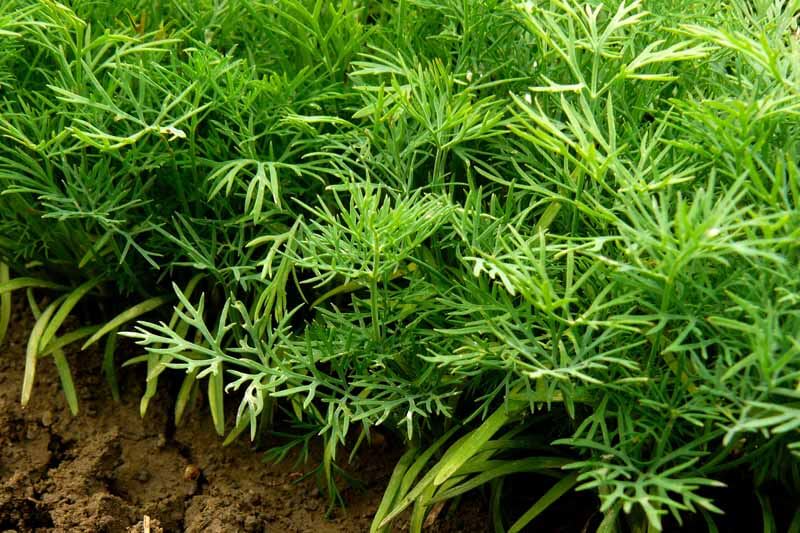
let the yellow-green umbel flowerheads dry for flavorful dill seed. Let some seeds fall to the ground and sprout for a second dill harvest in the fall.
Parsley (Petroselinum crispum) comes in curly and flat-leaved forms and lends fresh flavor to sauces, salads, and meats. Lush clumps of parsley leaves flourish in the cool spring weather and give way to flowering in the heat of summer, after which the plants die. If you replant parsley in the fall, it will often survive through winter.
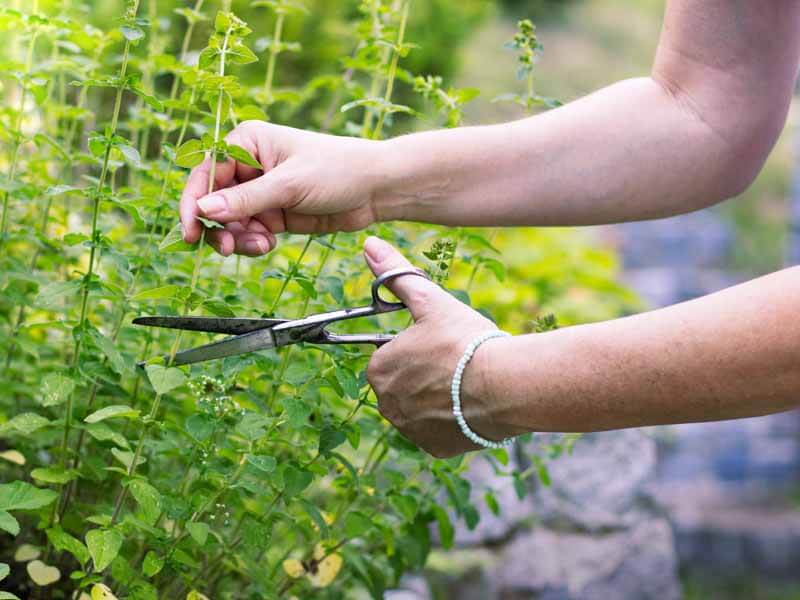
Sweet basil tastes like summer–whether used to flavor sauce, pesto or added to a citrusy summer drink. Mints of all kinds grow rampantly and need containment, but every gardener should have at least one pot of good mint. Thymes, especially lemon thyme, is a summer staple at my home that lends itself well to chicken, fish, salads, and vegetables. Oregano and piney rosemary are necessities for grilled meats and vegetables. These are the summer herb essentials.
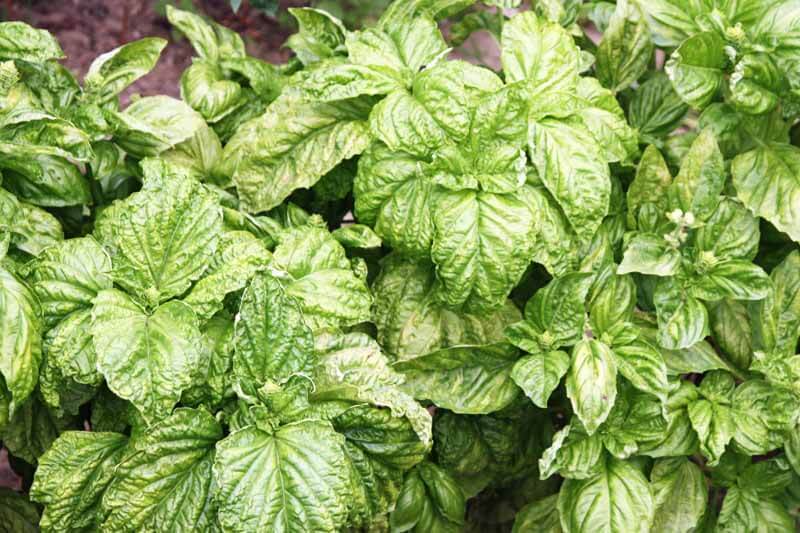
Basil (Ocimum basilicum) is a warm-season herb that’s grown as an annual. The key to keeping it sweet and flavorful is to clip off the flower heads as they appear. Grow it in the garden or in containers. (See the video below to learn how to care for container-grown basil.), and clip the leaves all summer to keep plants tidy and flavorful. (Click here to learn how to grow basil indoors in winter.)
Mint (Mentha spp.) leaves flavor summer mojitos, tabouli, and fresh mint tea. The plant is so easy to grow you can plunk a stem in a glass of water, and it will root in a week. Its aggressive nature is a mint’s only downfall. One seemingly harmless plant can take over a garden in no time, so plant it in a big pot filled with Black Gold Natural & Organic Potting Soil to keep its roots from roaming. When it starts to
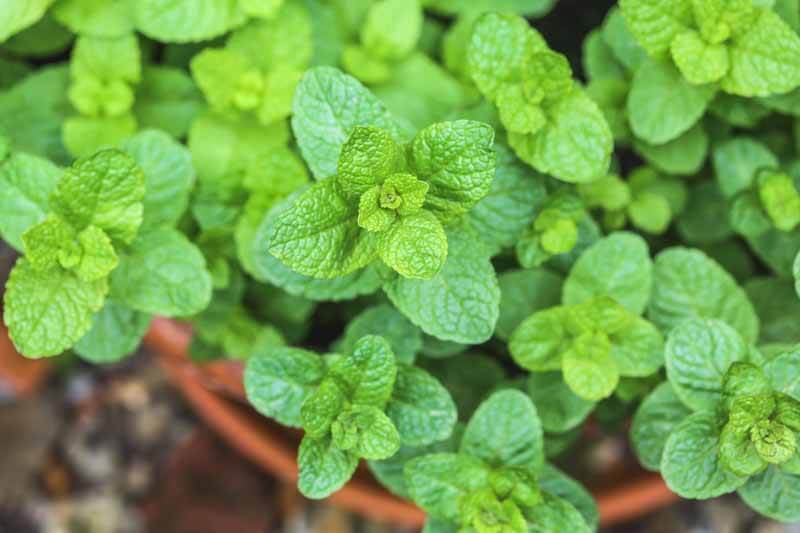
outgrow the pot, divide it, and give the spare to a friend (with fair warning).
Oregano (Origanum vulgare, Zones 4-10) has rooting stems that tend to spread, so be sure to give it space to grow. You can also contain oregano in a pot. Clusters of edible purple flowers bloom in midsummer, which attracts bees. Use the leaves to flavor meats, vegetables, and sauces in summer. In the fall, dry or freeze the leaves for winter cooking.

Rosemary (Rosmarinus officinalis, Zones 8-10) is a drought-tolerant, shrubby, evergreen herb with resinous needle-like leaves that taste great on meats and in sauces. Bees are attracted to its violet-blue flowers that bloom in late spring. The cold-tolerant variety ‘Arp’ (Zones 6-10) is a hardier option for northern gardeners. Dry the leaves for winter use.
Thyme (Thymus spp., Zones 5-9) has small, aromatic leaves that are evergreen. In late spring, the low, spreading, shrubby herb bears small clusters of flowers for bees that may be pink, purplish, or white. Plant it along a patio edge where it can spill across the pavement or in a pot. Harvest the leafy stems any time of year to add to many dishes or dry the leaves for herbal mixes.
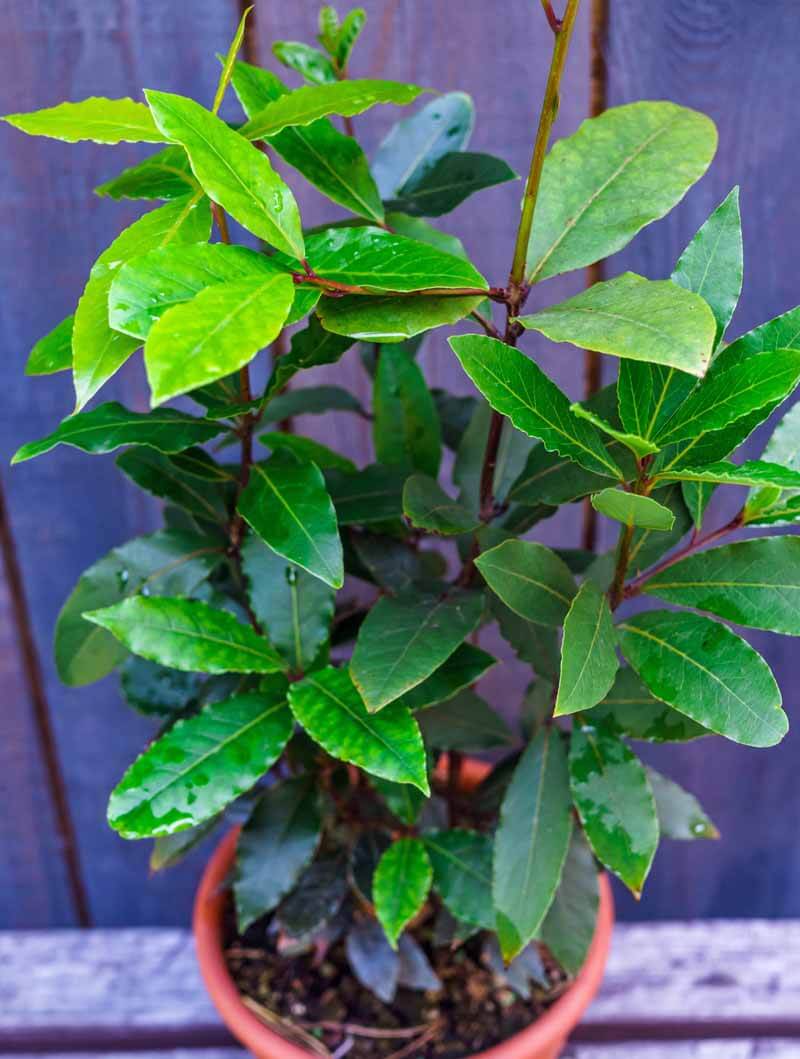
Sage tastes of turkey stuffing and pairs well with pumpkin. And bean soups never taste quite as good without the complement of winter savory. A big pot of bay leaf should be a winter houseplant for every gardener who cooks. Just be sure to take the pot outdoors in summer to let the Mediterranean tree to enjoy the sunshine. Spicy ginger is another indoor/outdoor tropical herb that will grow well in a sunny window. These are the essential herbs of winter.

Bayleaf (Laurus nobilis, Zones 8-10) will grow as a 20-30 foot evergreen tree where it is hardy, but if kept pruned in a pot, it will stay compact. Harvest the leaves for soups, sauces, and meats, but keep in mind that new leaves will not be produced until spring, so be sure not to strip the plant of all greenery and kill it. Pot-grown specimens thrive in OMRI Listed®Black Gold Natural & Organic Potting Mix. (Click here to learn more about growing bay leaf.)
Ginger (Zingiber officinale) grows very well as a potted house plant in a brightly lit spot with good humidity. Its roots can be harvested as the plants grow and used to make sweet and savory dishes. As with bay leaf, bring your potted ginger outdoors in summer to allow it to grow to its fullest. (Click here to learn more about growing ginger.)

Sage (Salvia officinalis, Zones 4-8) has felted, gray-green, evergreen leaves with a pungent flavor. The hardy shrubby perennial bears pretty lavender-blue flowers in summer, which are also edible and attract bees. It is best to harvest and dry leaves in the fall for winter cooking, but if you run out, you can always pick off a winter leaf or two without harming the plant.
Winter Savory (Satureja montana, Zones 6-8) The low, semi-evergreen winter savory looks attractive throughout much of the season. Its peppery leaves add flavor to green beans, soups, and stews. In summer, it has clusters of white or pinkish flowers that attract bees. Plant it along the edge of an herbal border.

To make it easy, all of these essential culinary herbs grow best in full sun and fertile soil with good drainage. Most are not too demanding when it comes to fertilizer, but a little all-purpose plant food at the beginning of the season never hurts. Spring is the best time to plant them, aside from tender indoor/outdoor herbs. Before planting, amend your garden soil with good compost, such as OMRI Listed® Black Gold Garden Compost Blend, to encourage good rooting and drainage.
When planning an herb garden, it’s smart to keep your annual and perennial herbs apart. Perennial herb borders are attractive and have permanence. They look right at home in raised beds or even pretty herbal rockeries. Just remember to reserve mints for big patio pots. Annual herbs are nice to plant among complementary vegetables. Dill is right at home planted alongside cucumbers, and almost everybody plants their sweet basil around garden tomatoes. Chamomile looks pretty when planted in a row beside spring greens or cabbages. Then keep your herbs harvested and well-tended to make the most of them all year round. (Click here to learn how to harvest and store herbs.)

“Will rosemary plants survive a mild winter in Zone 9?” Question from Linda of Fresno, California
Answer: Yes! Rosemary (Rosmarinus officinalis) is a drought- and heat-tolerant Mediterranean shrub made for California growing. Here are my top four favorite rosemaries that will grow beautifully where you live. Each is unique in its own way.
I hope that some of these great rosemary plants interest you.
Happy gardening,
Jessie Keith
Black Gold Horticulturist
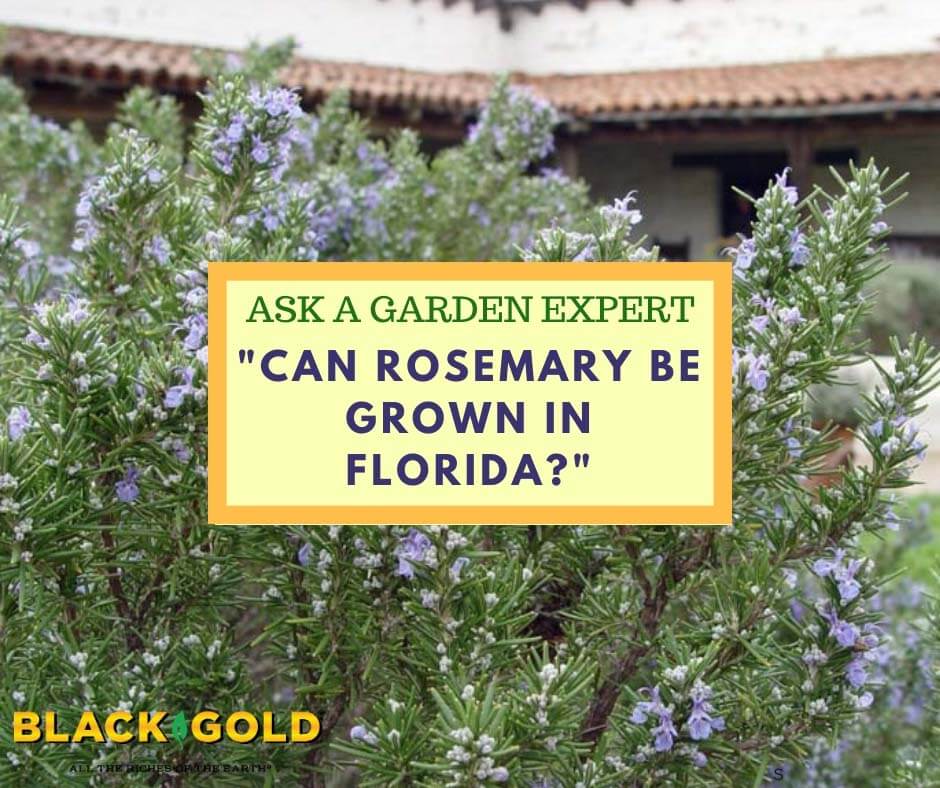
“Can one grow rosemary in Florida? Mine always dies.” Question from Jane of Tampa, Florida
Answer: Yes. Rosemary (Rosmarinus officinalis, USDA Hardiness Zones 8-10, 1-5 feet) can be grown in Florida, but it may need extra care because it is adapted to an entirely different climate.
Rosemary is native to the Mediterranean where it grows in upland, limestone soils, endures sunny, dry weather conditions through much of the year, and cool, dry winters. The hot, rainy, humid weather in Tampa, Florida is not what rosemary is naturally adapted to. This is probably the source of your trouble. Subtropical weather excesses can stress rosemary out, which can encourage pest and disease problems, with root rot caused by excess water being the biggest threat. With that said, you can grow it in Florida with care. Here are my suggestions.
I hope that these tips help. Now would be a good time to pot up a new rosemary plant due to Tampa’s milder January weather. (Click here to read more about growing rosemary.)
Happy rosemary growing!
Jessie Keith
Black Gold Horticulturist
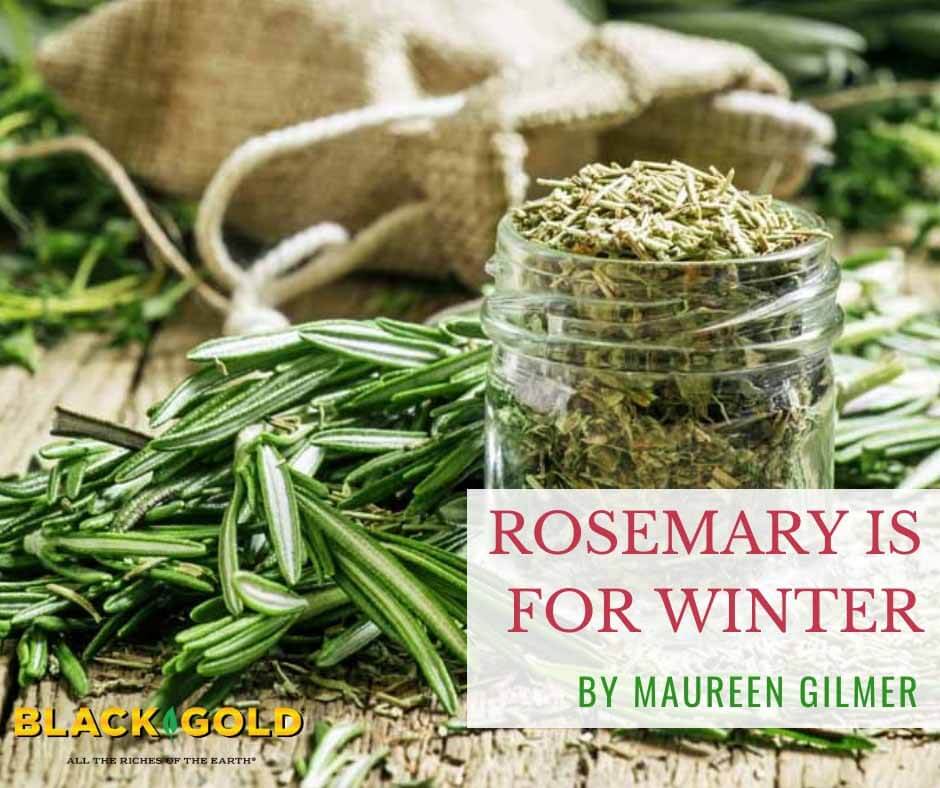
When I first came to the Southern California desert, I was shocked at how well traditional rosemary (Rosmarinus officinalis, USDA Hardiness Zones 8-10) shrubs survived through 120ᵒ F summer days. When provided good drainage and some water, these plants thrive in dry, mild-winter locations and reach mammoth proportions. If fragrant, culinary rosemary is able to thrive in low-desert heat and naturalize along the West Coast, it should grow well in practically every garden where it’s hardy. There isn’t a more useful plant for arid-zone landscaping, but rosemary also fares well as a potted plant where winters are cold.
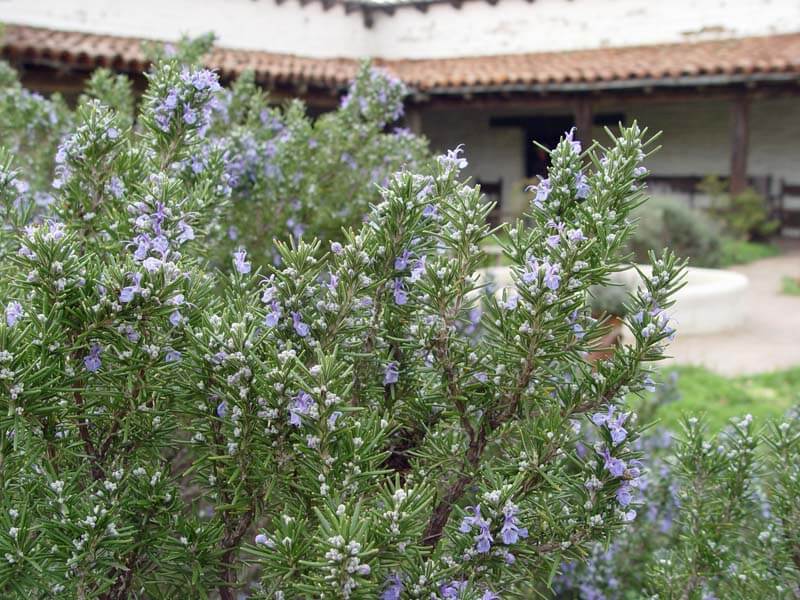
Rosemary is native to the Mediterranean and parts of Asia. It has a long history of use and cultivation going back thousands of years. Grown wherever possible outdoors in mild areas, whether as an ornamental or herbal plant, it has also been traditionally cultivated in pots in colder winter regions and brought indoors to shelter. As a house plant, rosemary can be clipped with scissors to release its scent, just as the Romans did to perfume their courtyards naturally. Greeks believed wearing sprigs of rosemary in the hair while studying assisted with memory, hence the plant’s perpetual association with remembrance. And, during the plague years, rosemary was burned as a disinfectant much like white sage smudge sticks have been used in the Americas for purification.
The sheer range of uses for rosemary should make everyone want to grow this easy and willing plant. It is above all a culinary herb, and foodies often use the straight twigs for savory beef or lamb kebab sticks or sprigs to naturally flavor roasts. As the leaves are heated, they release their plant oils. Rosemary may also be used to flavor olive oil, teas, and is an essential ingredient in many classic herbal mixes, such as Herbe’s de Provence, a provincial herbal mix from southern France. (Click here for a Herbe’s de Provence recipe and to learn more about classic French herbs.)
Rosemary has also been traditionally valued as a hair tonic. The Romans, being largely dark-haired, used it to create a hair rinse brewed with water and then cooled. It was poured on dark hair to cut residual soap accumulation and left hair shiny and beautiful. Blondes used the same technique with Roman chamomile (Anthemis nobilis).
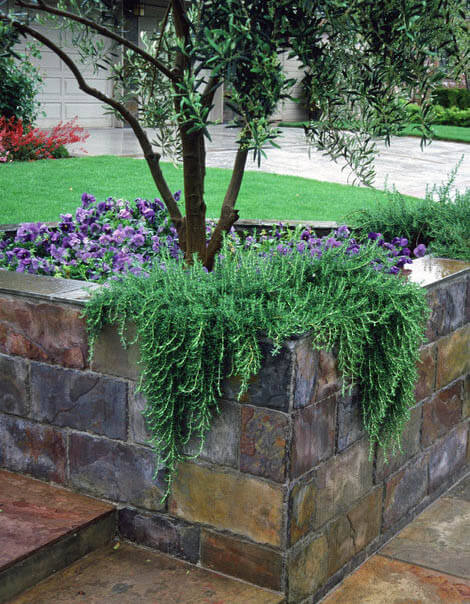
Rosemary averages 4 feet at maturity but can reach 6 feet tall in its natural, rocky, sunny habitat in the Mediterranean. Its narrow leaves become more silvery and needle-like in dry weather and greener and broader when rain is plentiful. Pale violet-blue flowers that attract bees may appear from midwinter to spring.
There are two basic forms. The standard or “official” form from the old herbals is Rosmarinus officinalis. Hardy to 10 or 20° F, it’s a long-lived evergreen shrub for mild-winter regions and often used for landscaping. The shorter variety, Rosmarinus officinalis ‘Prostratus’, develops a low mat of graceful, cascading foliage. Growing to about 1 foot tall, with almost an infinite spread, there is no better cascading plant for pot, slope, cliff, or wall. Its dark tresses are incredibly tough and prefer more shade than the upright type. It works well as a house plant due to having a shorter stature. There are named varieties of rosemary of varying sizes and flower colors, some are even hardier (the variety ‘Arp’ is touted as being hardy to Zone 6), so there’s one for all different sunny gardens. Everyone else can treat it as a house plant that comes outdoors for the summer.

Grow potted rosemary in a mixture of equal parts Black Gold Natural & Organic Potting Mix and Black Gold Cactus Mix to avoid overly damp conditions that cause root rot in arid-zone hill plants like these. Make sure there’s a big drainage hole or many small ones because rosemary must have fast drainage to avoid fungal infections that also plague lavenders, which like the same growing conditions.
There is no easier drought-resistant, long-lived herb, shrub, or useful plant to grow for home and garden that will make you feel like a pioneer woman. Rosemary is one plant that can teach you much about the cultivation of useful herbs. From a woman with a self-sufficient, pioneering attitude, a novice can learn hands-on how to harvest and prepare herbal material to use in the household and to make really fragrant gifts for family and friends.
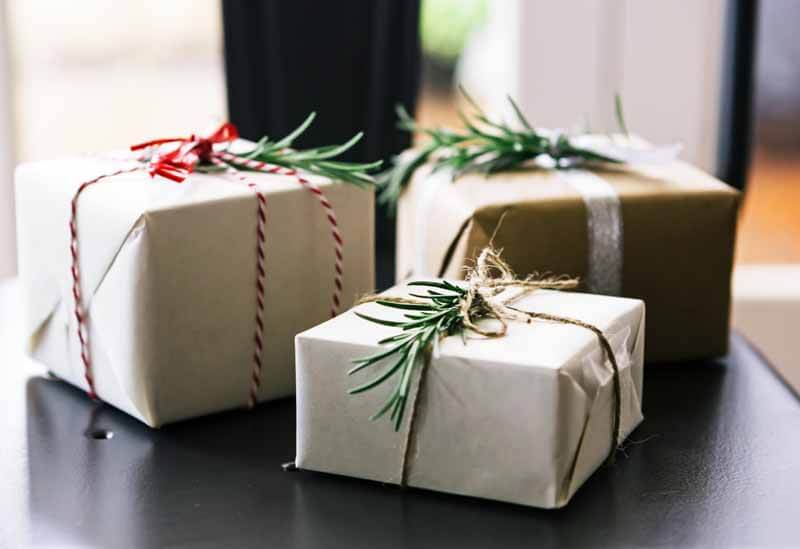
If you live where rosemary does not thrive year-round, buy a rosemary topiary to grow indoors, or invest in a potted 1-gallon rosemary to decorate for the holidays. Both will provide super fresh culinary clippings. Enjoy the indoor plants through the new year, then move them outdoors when temperatures warm up. And, where it’s mild year-round, plant your garden with lots of rosemary, so you have plenty of “mother” plants to snip and clip for the rest of your life.
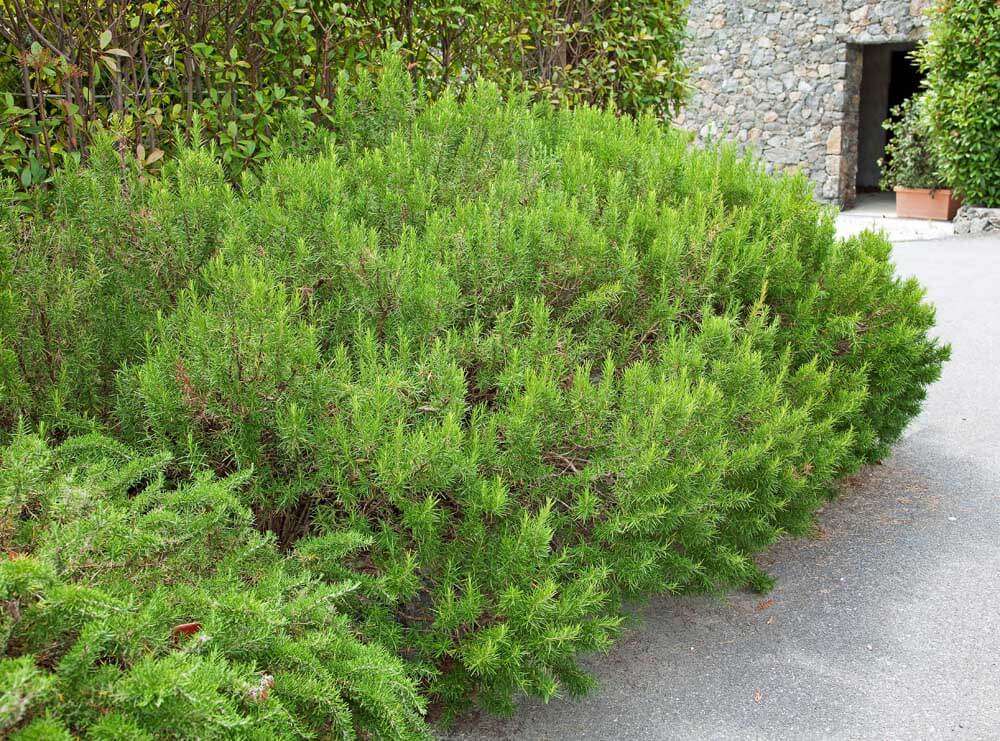
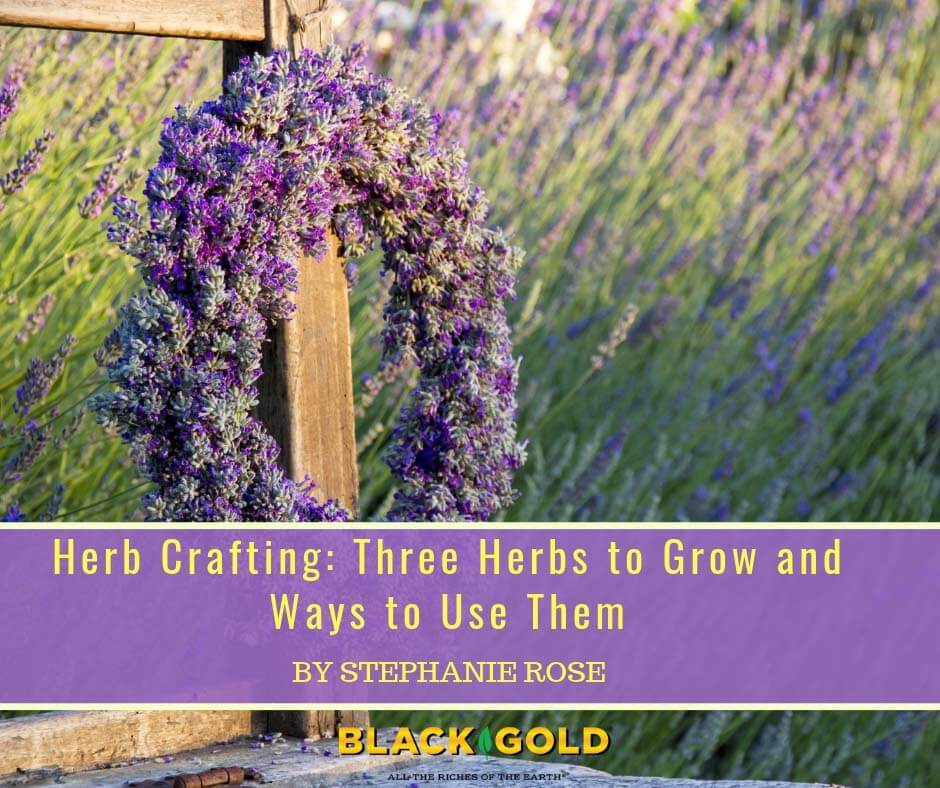
You don’t need a huge garden to make an abundance of herb crafts to benefit your home, garden, and artistic inclinations. Starting with just a few common and versatile herbs is an easy way to get your hands dirty and feel the magic of plants. I’ve chosen three herbs that are perfect for herb crafting because you can turn them into all sorts of potions, lotions, recipes, and garden crafts. Wait until you see all that you can create with these three familiar garden herbs: lavender, rosemary, and calendula.
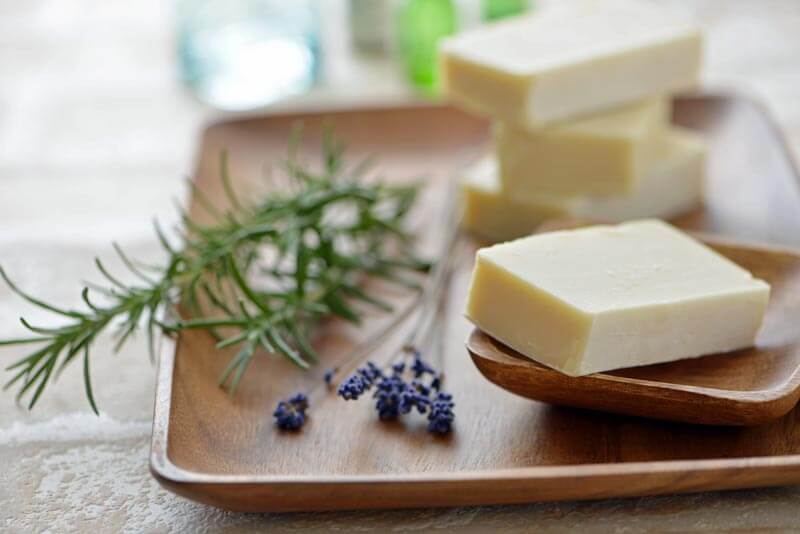
Lavender is my all-time favorite scent. It’s light, floral, and soothing, but even more, it has helpful herbal properties that can be used in your home, garden, on your skin, and also in the kitchen. The scent of lavender has a balance of sweetness and spice that makes it appetizing and appropriate for baking, tea, soda-flavoring, and all kinds of body care recipes. The scent promotes relaxation and exudes cleanliness, which makes it ideal for scentings linens and clothing. And its antiseptic and antibacterial properties make it a perfect aroma to freshen the air, your skin, and your home.
English lavender (Lavandula angustifolia, USDA Hardiness Zones 5-8) is native to the Mediterranean, so it loves climates with hot, dry summers and cool winters. It is drought-resistant and thrives in well-drained soil with some organic matter and a neutral to slightly alkaline pH (6.4 to 8.2). Plant English lavender in full sun and prune in both early spring and late summer to keep a neat and productive plant. Cut it back up to one-third while pruning and reserve the unopened flower buds and leaves to use in recipes around the house. (For a more detailed growing guide, read more here.)
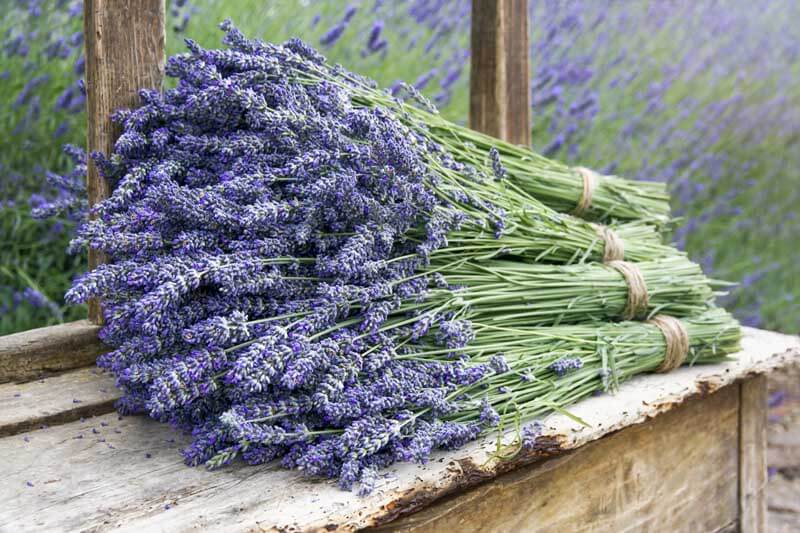
For dried flowers, harvest Lavandula angustifolia when it has visible purple buds but before the flowers open; buds retain better color and fragrance. Harvest the stems in the morning when the oil content of the leaves and flowers is the highest. Use sharp, clean pruners. (Leave some of the shorter bud stems on the plant for bees.) Gather the harvested stems into a bundle, tie them together with twine, and hang the bundle upside down to dry in a cool place away from direct sunlight.
When dry, roll the stems between your palms over a plate to catch the buds. You can also remove the leaves to infuse the oil, vinegar, and make tea. Store the dried flowers and leaves separately in airtight containers for up to one year.
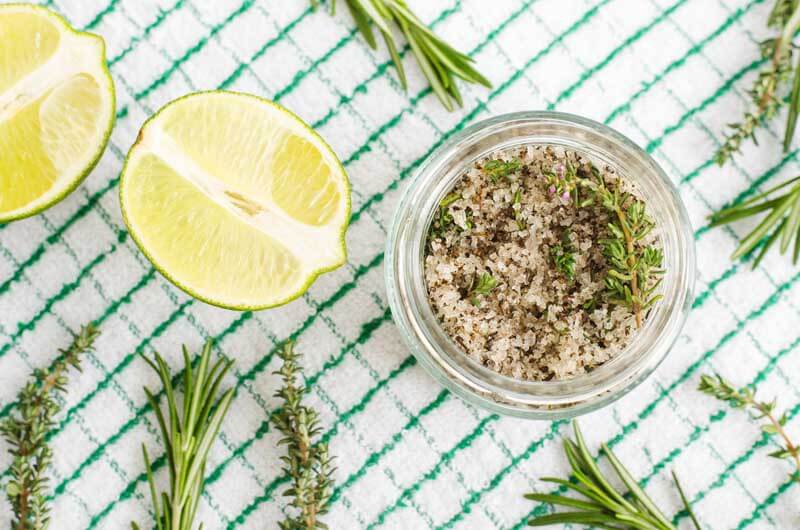
Rosemary has long been prized for its antiseptic and antibacterial properties. It is excellent for deodorizing and cleaning; the scent is purported to help focus and memory. In ancient times, scholars wore crowns of rosemary when studying for exams, so imagine how it can help you perk up in the morning shower! Did you know that rosemary is also well known to be THE herb for healthy hair? It stimulates hair growth and adds shine.
Most of all, rosemary is beloved for its delicious flavor in recipes. It ramps up a roast and cooked root vegetables and adds an earthy punch to soups and stews. Whether you are freshening up your home, trying to wake up or adding oomph to hearty recipes. Rosemary can’t be beat!
Rosemary cultivars have variable hardiness. Most overwinter in USDA Hardiness Zones 8-10, but some hardier varieties, like ‘Arp’, may survive in Zones 6 or 7. Otherwise, grow rosemary in a pot that you can bring indoors in fall or grow it as an annual. It likes well-drained soil and full sun. Rosemary does well in dry conditions, so be careful not to overwater it. Overwatering rosemary can commonly lead to root rot.

Cut sprigs of rosemary to use fresh or tie them up in a bundle to dry, the same way you would with lavender. When dry, remove the leaves by pinching the top of the stem with your finger and thumb and running it along the stem to the bottom. The leaves will pop right off. Keep dried rosemary sealed in an airtight container for up to one year.

Many people view calendula as an annual garden flower, but with so many healing properties and beneficial uses, herb nerds see it more as a versatile garden herb. It’s been used for thousands of years to help heal minor wounds and inflammations, has a bright and sunny personality that attracts a host of beneficial insects to the garden, and it could not be easier to grow. Include calendula in your herb garden this year for some pops of color and fun herbal crafts.
Calendula is an annual that grows easily from seed either sown directly in the garden or indoors. Begin seeds indoors about eight weeks before transplanting calendula in the garden. Plant your calendula somewhere in the garden with good soil amended with fertilizer-boosted Black Gold Earthworm Castings that gets a lot of light but isn’t extremely hot. Deadhead and harvest the flowers liberally throughout the season, and you’ll have continual blooms to pick from spring to fall.
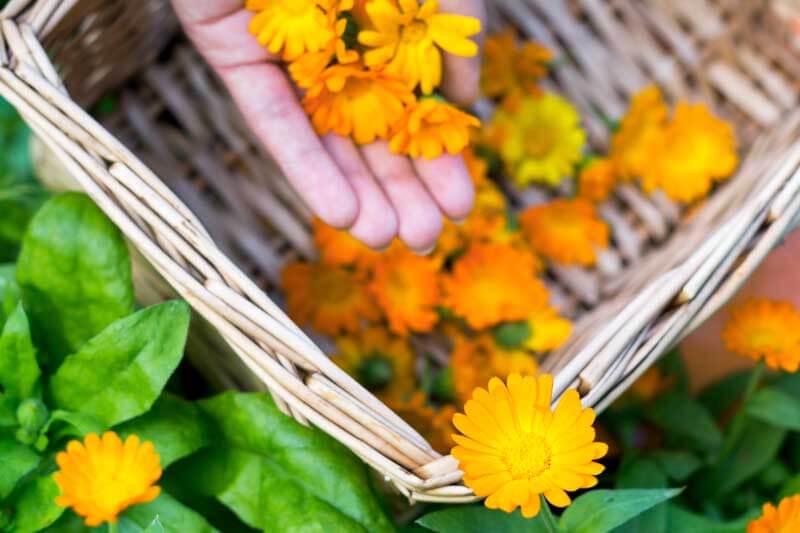
Harvest the full flower heads from new blooms and spread them out in a single layer in a drying screen (which can be as simple as using a window screen) or setting them in one layer in a shallow basket. Leave the flowers in a well-ventilated area that is cool, dry, and away from direct sunlight. After a few days, test for dryness. The petals should sound crunchy and not feel cool to the touch. Store the dried flowers in an airtight container for up to one year.

Fresh-from-the-container culinary herbs turn a New York loft, a Chicago studio, or a Los Angeles condo into flavor central. Nothing is quite like fresh mint in your mojito, just-picked basil on a mozzarella sandwich, or cilantro in your salsa. No store-bought herb carries this intense flavor, because once cut, the essential oils immediately begin to lose pungency. Cut and eat immediately, and you’ll find intense herbal resonance in every dish you make.
In a single good sized pot or any other repurposed vintage container, it’s possible to plant a garden of culinary herbs today and start tasting in just a matter of weeks.
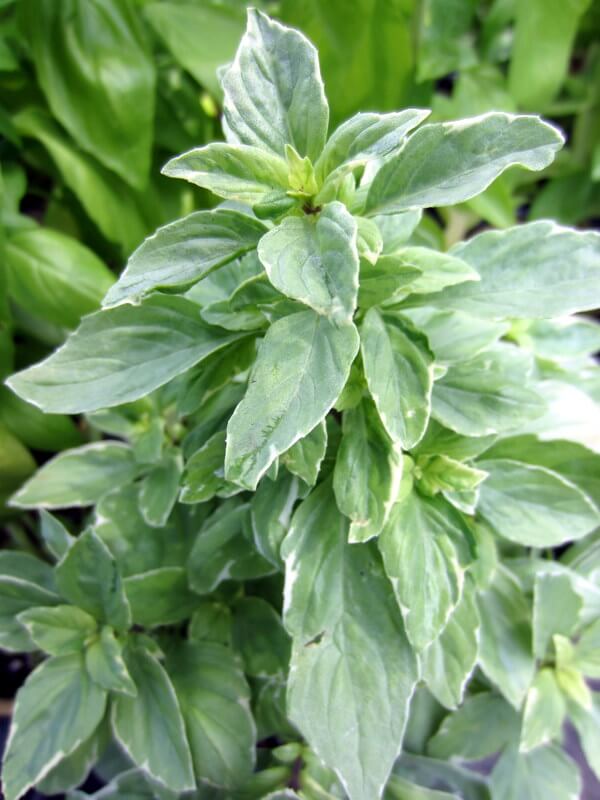
Blending the right herbs that share similar preferences makes care and watering a snap. Most herbs need direct sun, so choose a bright planting spot, such as a fire escape, a window box, a terrace, or balcony. Just beware of direct exposure to the heat of intense afternoon sun, and be sure to water heavily on a daily basis at the height of summer.
In cities like Chicago, winds whip through downtown creating challenges for rooftop gardens and other plants exposed to such conditions. As we approach summer, the wind combines with the hot sun, causing herb garden to struggle for moisture. It dries herb’s tender, oil-rich leaves if moisture is inadequate.
Thanks to the amazing ability of Black Gold Moisture Supreme Container Mix, contained herbs will stand up to the rigors of urban life without fail. This amazing moisture-holding potting soil ensures that when your pot heats up, your plants don’t suffer wind damage due to the strengthening effects of RESiLIENCE®. Despite its absorptive qualities, this potting soil also provides adequate drainage to ensure there’s plenty of oxygen in the root zone.
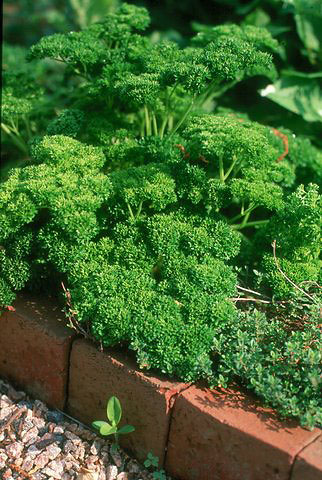
An annual herb garden typically features two popular summer plants: cilantro and basil. Both are annuals grown fresh from seed each year and mature into large plants. These blend perfectly with chives for a triad of often used and delicious foliage. If perennially nipped and cut, they remain small for a time, but with rising heat and extended days, they will stretch out to flower and their flavor will become stronger and less palatable.
The second group is the smaller, long-lived perennial herbs sized for a grand herb pot. In-ground gardeners treat these as landscape plants, enjoying new growth and harvest each year without replanting, though overwintered plants may lose verve and require some replacement in the future. Key to success is growing the right herbs that won’t become too large over the season. Start with those you use most often and organize them in pots by form with spreaders around the edges and upright herbs toward the center.
Thyme is one of the best cascading herbs that will spill over the edge of the pot, buying room for more upright plants in the center. Oregano is spreading too, but since this herb is so often used in the kitchen, it manages to retain a modest size from frequent pinching. Sage is very slow growing and loves the sun, so place this fuzzy-leaved fellow on the hot side of the box. The same is true for creeping groundcover rosemary that spills off the face of the box. Plant purple fennel in the center for an incredible bronze-colored haze that yields lots of anise-flavored cuttings for cooking and baking.
Everyone can dive into herb gardening no matter where they live by selecting a large, well-drained container, and using high-quality potting soil to reduce watering demands. Once planted, begin dreaming of all sorts of herbal dishes, then snip your way to fresh and easy all summer long.